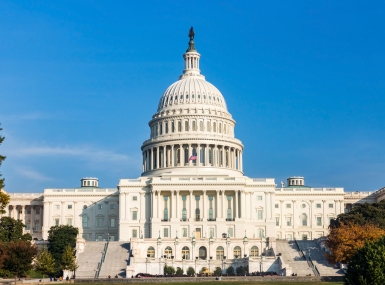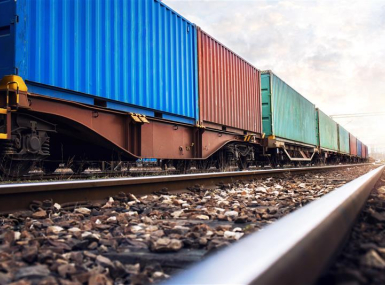House Democrats pass $1.5 trillion comprehensive infrastructure package
Upcoming Events
Related News

Key Takeaways
On June 4, Democrats on the U.S. House Committee on Transportation and Infrastructure (T&I) introduced H.R. 7095, the Investing in a New Vision for the Environment and Surface Transportation (INVEST) in America Act, a $494 billion, five-year surface transportation authorization. Through its four divisions, the surface bill would largely extend current law (P.L. 114-94) for highways and transit through FY 2021 (Division A), followed by new and existing authorizations for these programs from FY 2022 through 2025 (Division B). Pipeline safety and hazardous materials safety programs (Division C), as well as rail provisions (Division D), would be newly authorized from FY 2021 through FY 2025.
On June 18, House T&I favorably passed the bill, as amended, out of committee along party lines following its re-designation as H.R. 2 and a contentious two-part, 24-hour markup that saw the consideration of roughly 300 amendments from both sides of the aisle, including an amendment from T&I Republicans introducing their own version of a surface transportation reauthorization, the Surface Transportation Advanced through Reform, Technology, and Efficient Review (STARTER) Act, that was defeated by T&I’s Democratic majority. View NACo’s comprehensive analysis of the House T&I Democrats’ surface transportation authorization (Divisions A—D of H.R. 2) here.
On June 22, House Democrats built on T&I’s progress, further advancing their vision for a comprehensive infrastructure package with the release of the remaining legislative text for H.R. 2 based around their January framework, which rolled a five-year surface transportation reauthorization in with funding for ports, airports, clean energy, clean water and clean drinking water, Brownfields restoration projects and broadband deployment. The bill also contains authorizations for public housing, schools and hospitals that were not outlined in the Democrats original proposal. Including these additional provisions, the proposal has doubled from a projected $760 billion in January to its current price tag of roughly $1.5 trillion dollars, with a projected $140 billion shortfall in the surface transportation portion alone. View NACo’s comprehensive analysis of H.R. 2, the Moving Forward Act, here.
Initially beginning with the surface transportation’s four divisions, H.R. 2 as it currently stands has been expanded to include, in total, 13 divisions:
- Division A: FY 2021 surface transportation authorization of current law, plus additional Highway Trust Fund authorities for highway and transit programs
- Division B: FY 2022 through FY 2025 surface transportation reauthorization for highways and transit
- Division C: FY 2021 through FY 2025 reauthorization for USDOT’s Pipeline and Hazardous Material Safety Administration
- Division D: FY 2021 through FY 2025 rail reauthorization
- Division F: Water resources infrastructure
- Division G: Broadband, vehicle safety, clean drinking water, clean energy, electric vehicle deployment and healthcare infrastructure
- Division H: National Scenic Byways program
- Division I: U.S. Postal Service
- Division J: Public housing
- Division K: Public schools
- Division L: Public lands, tribal infrastructure and resilient natural infrastructure
- Division M: Bonds and other financing tools
Top line numbers for program authorizations within the INVEST in America Act include the following over FY 2021 through FY 2025:
- $494 billion for a five-year surface transportation reauthorization, including:
- $319 billion for the Federal Highway Administration
- $105 billion for the Federal Transit Administration
- $60 billion for the Federal Railroad Administration, including $29 billion for Amtrak
- $37.5 billion for airports through the Federal Aviation Administration’s Airport Improvement Program and additional supplemental funds
- $10 billion for the U.S. Army Corps of Engineers to address the nearly $100 billion worth of authorize water resource projects
- $10 billion for community health center infrastructure upgrades and capital projects
- $40 billion for clean water investments
- $70 billion for clean energy grant programs
- $100 billion for the deployment of broadband infrastructure, especially in rural areas
- $10 billion for community health center infrastructure upgrades and capital projects
- $70 billion to address the backlog of affordable housing capital projects
- $100 billion for the long-term improvement of public schools, especially high-poverty schools
In addition to spending levels authorized in the bill, H.R. 2 would also address funding and financing tools important to counties, including the reinstatement of Advanced Refunding Bonds and Build America Bonds. The bill also includes a full unlock of the Harbor Maintenance Trust Fund, which would provide the Corps access to the fund’s roughly $10 billion balance for use on harbor maintenance projects. NACo supports the full expenditure of harbor maintenance trust fund collections on dredging and harbor maintenance, while also providing equity for deep draft ports that contribute collections to the fund but do not have significant dredging needs by allowing them to utilize trust fund dollars for limited port-related uses other than dredging.
The very last title of the bill addresses the Highway Trust Fund (HTF), however, not in a meaningful way. It would extend current taxes on motor fuels and other sources of revenue for the HTF, which are already known to be insufficient, and provide for an additional transfer of about $144 billion from the general fund of the U.S. Treasury to cover the remaining shortfall. Upon release of the bill on June 22, U.S. House Majority Leader Steny Hoyer (R-Md.) signaled that his conference would be looking toward the White House to determine the package’s funding mechanism.
Notably, this legislation does not include a reauthorization for the U.S. Army Corps of Engineers (Army Corps) to advance water resource projects, as was initially proposed in the House’s January framework. Traditionally, the Army Corps’ authorization – a renewal of the Water Resources Development Act that is more commonly referred to as WRDA – is renewed cleanly every two years on a bipartisan basis. This signals that House Democrats likely realize the near impossibility of their package clearing necessary hurdles in the U.S. Senate but still want to see the Army Corps bill reauthorized when it expires on September 30, 2020. To this end, House T&I plans to release their version of WRDA later this year. Similarly, the U.S. Senate Committee on Environment and Public Works is working on drafting its own clean, two-year WRDA bill.
On June 30, the U.S. House of Representatives began consideration of the bill. The following day, on July 1, H.R. 2 passed the House along predominantly party lines, with two Democrats and an Independent voting against the bill and three Republicans crossing the aisle to support the package. View the vote’s roll call here.
Broadly – if enacted into law – H.R. 2 would do the following:
- Increase funding for surface transportation programs by 62 percent over current levels prescribed by the FAST Act (P.L. 114-94)
- Substantially increase direct funding opportunities for counties to advance surface transportation projects by creating or reviving over 20 new grant programs, the majority of which could be applied for directly through USDOT
- Allow FY 2021 highway and transit funds to be used at a 100 percent federal cost share to assist communities recovering from COVID-19
- Maintain and increase the off-system bridge set-aside to over $1 billion annually
- Increase sub-allocation amounts for counties through the Surface Transportation Block Grant program
- Prioritize returning surface transportation assets to states of good repair versus providing new capacity for motor vehicles and increase active transportation opportunities
- Unlock the Harbor Maintenance Trust Fund
- Invest $130 billion in grants and bonds for infrastructure improvements in high-poverty public schools
- Authorize $10 billion in grants for childcare facility improvements to increase child safety and meet health requirements created by the COVID-19 pandemic
- Create new options for State Revolving Funds under the Federal Emergency Management Agency for hazard mitigation projects
- Prohibit state barriers and restrictions on municipal-owned broadband networks that are currently in place in 22 states where counties are either impeded or prohibited entirely from owning or operating municipal broadband networks
- Make roads in rural areas that primarily service the agriculture industry eligible for funding under the Surface Transportation Program
- Provide $700 million annually to establish a new program for projects that improve resiliency, performance or efficiency of the electricity grid
- Direct states to coordinate with local governments and other entities in the development of state energy plans
- Authorize $10 billion through a new competitive process within the Community Development Block Grant program
- Authorize $5 billion for the Home Investment Partnerships (HOME) program
- Increase state Low Income Housing Tax Credits annual allocations
- Increase funding allocations and make permanent the New Markets Tax Credit program
While the House pushes forward with its vision for infrastructure, U.S. Senate committees of jurisdiction continue their work to draft titles for rail, safety and public transit programs to complement the U.S. Senate Committee on the Environment and Public Works’ highway bill, S. 2302, the America’s Transportation Infrastructure Act (ATIA). ATIA is also a five-year reauthorization, providing $287 billion for federal highways from FY 2021 through FY 2025. In comparison to the highway title proposed by House Democrats, ATIA’s funding level is a $32 billion (10 percent) decrease. Senate EPW passed the bipartisan measure out of committee in summer 2019. The upper chamber’s Republican majority has not signaled action around a broader package that would match the House’s action, nor is it clear when the remaining Senate committees will act.
Counties believe that a strong intergovernmental partnership is key to strengthening our nation’s infrastructure and bolstering economic recovery for local governments hit hard by the COVID-19 pandemic. As owners and operators of 45 percent of public roads and nearly 40 percent of the National Bridge Inventory and direct supporters of 78 percent of the nation’s public transit systems and 34 percent of public airports, counties play a critical role connecting people, businesses and economies. We invest $134 billion annually in the construction of infrastructure and maintenance and operation of public works, including $83 billion in community health and hospitals; $60 billion in the construction of public facilities, such as hospitals, schools, jails and other local institutions; and $21.6 billion in sewage and waste management. Counties urge Congress to recognize the significant role that local governments play in the national transportation and infrastructure networks by working together to address county priorities, including:
- Providing for a strong federal-state-local intergovernmental partnership that maintains local decision-making
- Dedicating funds for locally owned infrastructure
- Preserving the tax-exempt status for municipal bonds
- Streamlining the federal regulatory process while ensuring good environmental stewardship
- Bringing long-term certainty and solvency to the federal Highway Trust Fund

Attachments
Related News

U.S. House of Representatives passes SPEED Act and other permitting reform bills
On December 18, the U.S. House of Representatives passed the SPEED Act (H.R. 4776). The SPEED Act would strengthen county involvement in decision-making and make needed commonsense reforms to the federal environmental review process.

Counties and Railroads: Shared Priorities for the Next Surface Transportation Bill
County leaders from across the country have a vital opportunity to ensure their infrastructure priorities are front and center.

House lawmakers introduce bipartisan legislation to support World Cup local transportation needs
On December 2, U.S. Reps. Rick Larsen (D-Wash.-02) and Burgess Owens (R-Utah-04) introduced the Transportation Assistance for Olympic and World Cup Cities Act (H.R.6348), a bipartisan effort to strengthen local transportation systems in communities preparing to host major international sporting events